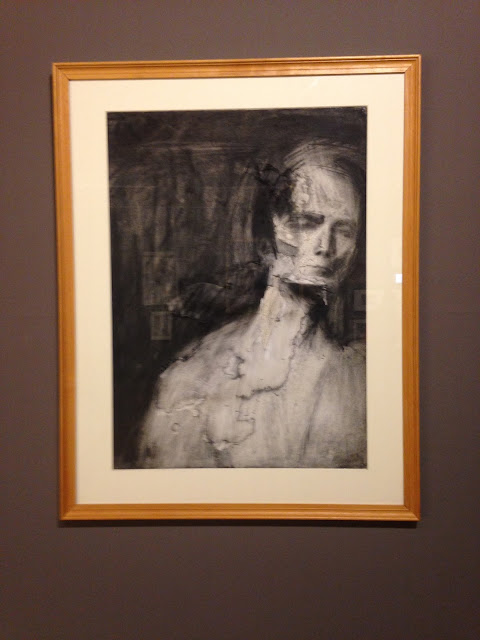 |
| Frank Auerbach, Head of EOW, 1960 - detail (artist copyright) |
I visited the
Whitworth Art Gallery the other day for the first time since its grand reopening. The main exhibition rooms were closed for a rehang but it was still a wonderful experience; the Whitworth is up there with the best art museums in the country, not because its collection is necessarily better than anyone else's, but because the whole experience of looking at the work is relaxed and interesting.
 |
| Auerbach, Head of EOW, 1960, charcoal on paper (artist copyright) |
The highlight for me was a portrait in charcoal by Frank Auerbach, a similar piece to the drawing of the same sitter in the
current Tate exhibition, but if anything more powerful. I don't know whether this is the case or not, but the German writer WG Sebald must have had Auerbach in mind when he created the character of Max Ferber in his novel
'The Emigrants', Ferber being an artist who keeps erasing and reworking his drawings until his studio is covered in a thick layer of dust.
I was peering at the specks of charcoal dust that had fallen onto the liner of the frame when a fellow visitor to the gallery said something about the power of the work, and we struck up a conversation. I pointed out the way the paper had been torn in places by the youthful Auerbach's fierce technique; she noted in turn the bold straight lines and angles which add to the energy and strangeness of the portrait. We chatted for ten minutes or so, and for that short time it was as if talking about pictures with a complete stranger was the most natural thing in the world.
 |
| Auerbach, Head of EOW - detail (artist copyright) |
In this striking portrait, the sitter seems about to topple sideways out of the frame. I love the fact that the artist's every gesture remains visible, all the bold strokes and moments of indecision. They're still there, recorded in this simplest of media, although I'm sure museum conservators must wish Auerbach had used a less violent technique. How on earth do you preserve such woefully damaged paper for posterity?
The Auerbach piece is hanging in a vast display of portraits, which together form a sort of portrait of the museum and the people associated with it. All shapes, sizes, periods and media are represented in the most exuberant way, the pictures arranged visually - in patterns - rather than by date or type. There are no labels or text panels, but you can pick up a simple booklet with all the info, and carry it round with you.
Personally, I like this approach. It allows you to escape from your own preconceptions and prejudices and concentrate on looking. If something grabs you, then you can refer to the notes. A member of staff explained that the pictures were hung salon-style like this as a nod to 19th century customs, and isn't it better to have lots of work out on display, rather than stuck in a store room - even if you have to crane your neck a bit to see some of it?
 |
| Richard Forster, Three Verticals on consecutive but random time intervals, Saltburn-by-the Sea, 21 Jan 2009 (artist copyright) |
The power of simplicity was also evident in
Richard Forster's work. When I saw the triptych above I thought at first that it was made up of three photographs, but something wasn't quite right. On closer inspection they turned out to be pencil drawings, and in the next room were many more. Forster works in series, exploring particular places according to time sequences suggested by phenomena like the tides. His chosen medium is perfect for this kind of project, allowing him to create images that resemble the fuzzy black-and-white photos used by Sebald in his books, but with an added mystery and shimmer.
 |
| Richard Forster, installation view at Whitworth Art Gallery |
 |
| Richard Forster, American Pastoral - Ostalgie Pattern with Tape, 2011 (artist copyright) |
Richard Forster's exhibition continues at Whitworth Art Gallery until the end of February.








No comments:
Post a Comment